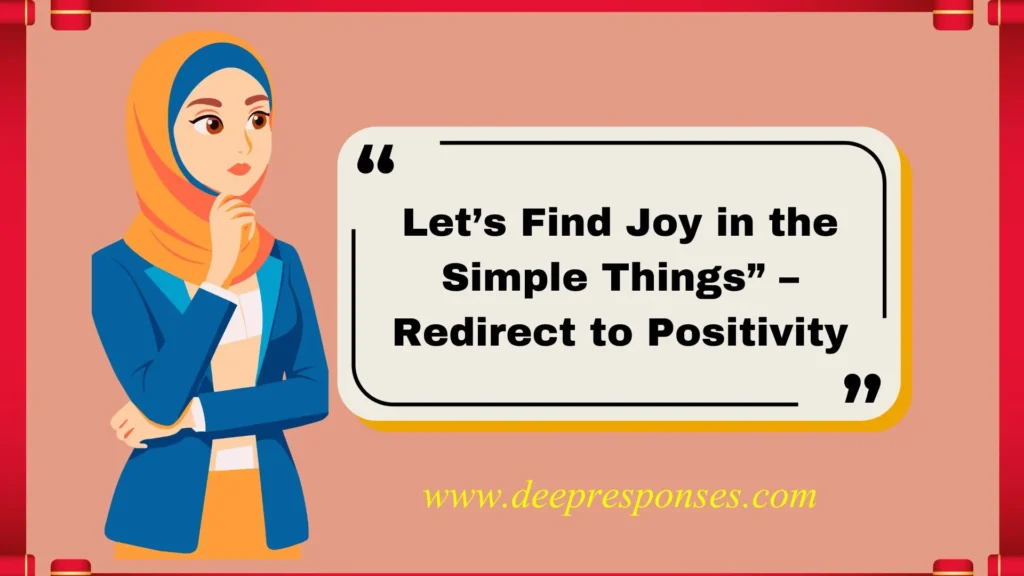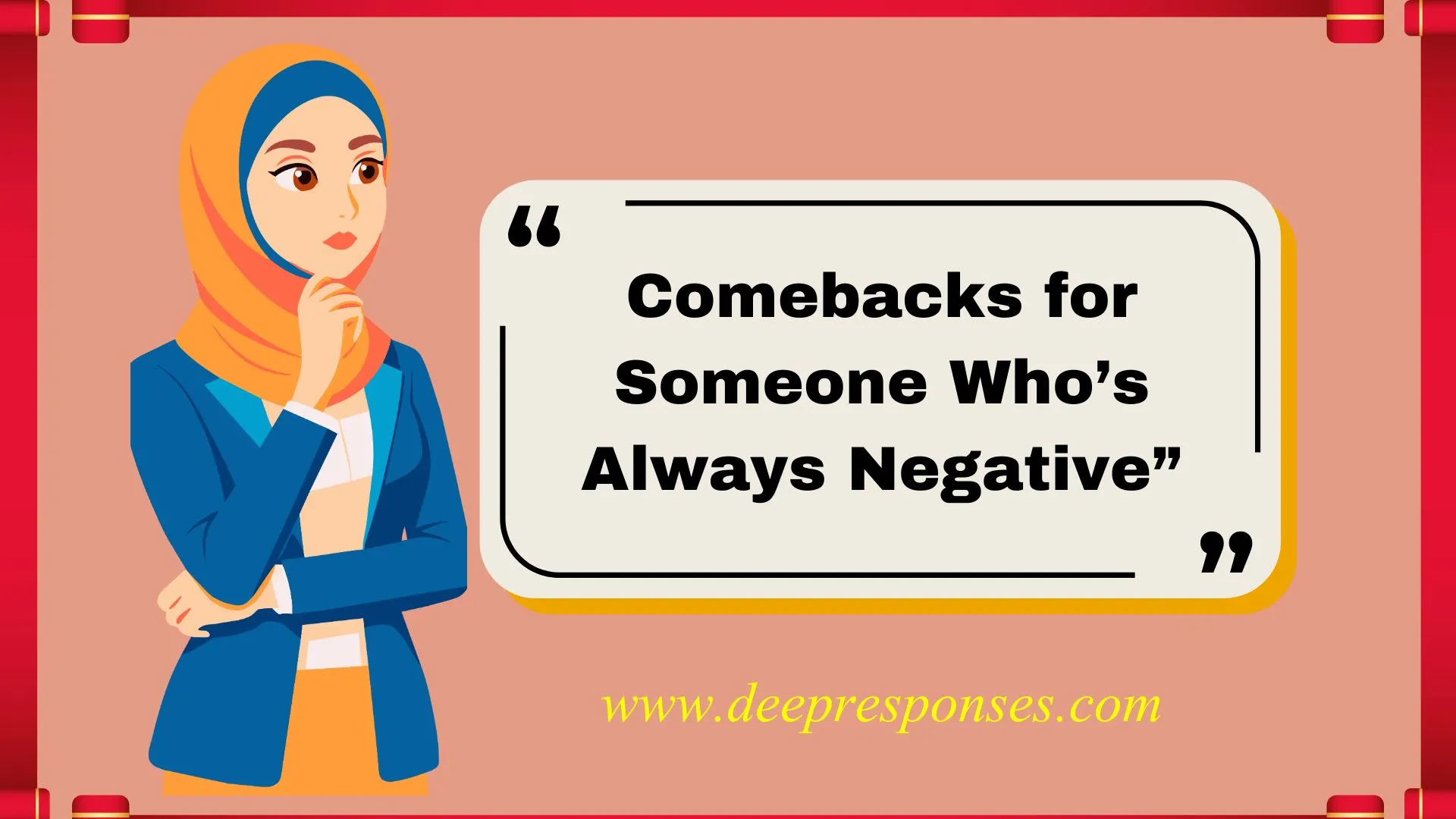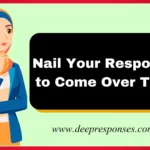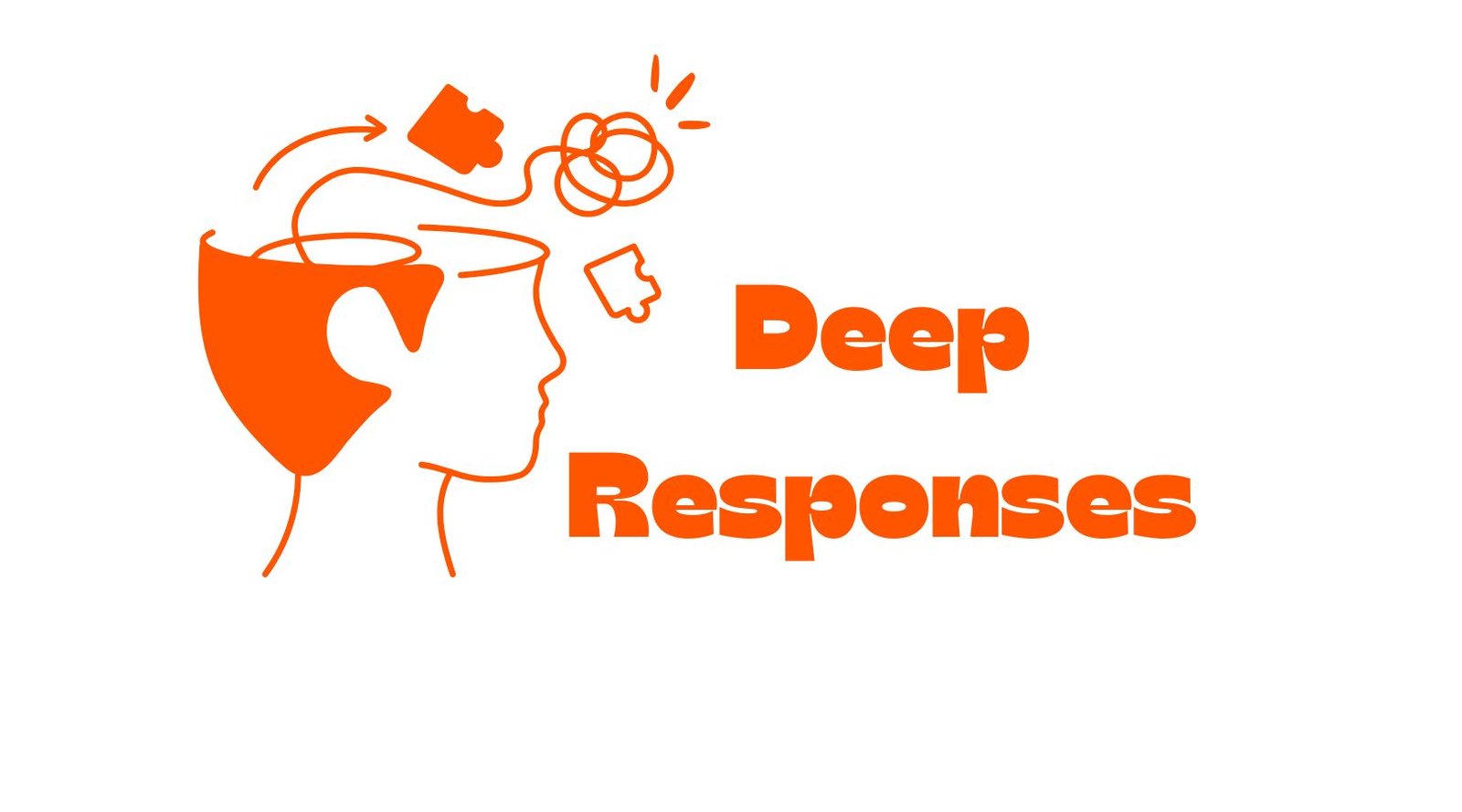Negativity can be draining, especially when someone constantly spreads it. Whether it’s a coworker, friend, or family member, dealing with persistent negativity can be challenging.
This article provides 25 effective comebacks to help you handle such situations gracefully and constructively. These responses are designed to be empathetic, firm, and uplifting, ensuring you maintain your own peace of mind while addressing the negativity.
1. Why So Negative?” – Reframe the Conversation
- I noticed your concerns, but have you thought of the positives here?”
- What’s really bothering you? Let’s tackle it together.”
- Negativity rarely solves problems—what’s a good solution we can try?”
- Let’s flip this around. What’s something good about this situation?”
- I hear you, but focusing on solutions might feel better.”
- We all face tough days—what’s one small win you had recently?”
- I’d love to help, but can we approach this constructively?”
- What’s something you’re grateful for today?”
- Your feelings matter, but let’s try a more empowering perspective.”
- Negativity can weigh us down. What can uplift you right now?”
2. Let’s Find the Bright Side” – Encourage Optimism
- What’s one good thing you can see in this?”
- It’s easy to get stuck in the negatives. Let’s shift our focus.”
- I get it—it’s tough. But what’s the silver lining?”
- Every cloud has a silver lining. What do you think it could be?”
- This might be hard now, but how might this help you grow?”
- I know this is frustrating. What’s something good happening elsewhere in life?”
- Negativity won’t change the outcome. Let’s brainstorm solutions.”
- What would a positive takeaway look like here?”
- Focusing on the bad can be exhausting. Let’s lighten things up.”
- What’s one thing that brings you joy right now?”
3. Negativity Drains Energy” – Highlight the Impact
- Do you notice how negativity affects the vibe here?”
- Your words are powerful. Can we use them for something uplifting?”
- Have you ever tried focusing on solutions instead of problems?”
- What would happen if we focused on progress, not problems?”
- Negativity is contagious—let’s stop it in its tracks.”
- How can we make this space more positive together?”
- Do you feel better or worse after dwelling on the negatives?”
- It’s important to vent, but solutions make us feel lighter.”
- Negativity impacts everyone here. How can we improve this?”
- Words shape reality—what’s a better way to frame this?”
4. Constructive Feedback is Key” – Redirect Criticism
- I hear your concerns. What’s a constructive way to address this?”
- Criticism is valid when paired with solutions. What’s your idea?”
- Let’s turn this into actionable feedback. What can we do differently?”
- Instead of what’s wrong, what’s one thing we can improve?”
- Your input matters. How can we make it more constructive?”
- Negativity can shut down conversations. Let’s keep it open.”
- Feedback is helpful—how can we rephrase this to be actionable?”
- Your perspective is valid, but solutions will move us forward.”
- What’s a productive suggestion you’d like to share?”
- Criticism is easier to hear when paired with encouragement.”
5. Spread Positivity Instead” – Promote Better Habits
- What’s one way we can make today better?”
- It’s easy to focus on problems, but solutions feel better.”
- Let’s challenge ourselves to see the good here.”
- Positivity breeds positivity. What’s a kind thing we can say?”
- Negativity is heavy. How can we lighten the load?”
- Spreading positivity feels more rewarding. Want to try?”
- What’s one positive thing about this moment?”
- We rise by lifting others—what’s something uplifting to share?”
- Negativity drains us. Let’s focus on what energizes us.”
- Kind words go a long way. Let’s use them.”
6. Is This Helping?” – Question the Negativity
- Do you feel better after focusing on the negatives?”
- Is this line of thinking helping or hurting?”
- What’s the outcome you hope for? Let’s work towards it.”
- Does venting solve the issue? What will?”
- Have you tried approaching this from another angle?”
- What would be a more empowering way to see this?”
- If negativity isn’t solving it, what will?”
- Let’s ask ourselves: is this thought helpful?”
- What’s a better use of our energy right now?”
- Does this conversation lead us closer to a solution?”
7. Focus on What You Can Control” – Shift the Perspective
- What part of this situation can you change?”
- Sometimes, all we can control is our reaction. What’s a calm way to approach this?”
- If you can’t control it, is it worth all this energy?”
- Let’s focus on what’s in your hands rather than what isn’t.”
- Dwelling on the uncontrollable only brings frustration—what’s the next step forward?”
- What can you actively do to make this better?”
- Since you can’t change the past, what’s one thing you can change now?”
- Let’s work on solutions you can influence.”
- Energy spent on negatives could be used to fix things. Where should we start?”
- If you focus on solutions, you’ll feel more empowered.”
8. That’s One Way to See It” – Offer a Different View
- That’s an interesting take. What about this perspective?”
- I see where you’re coming from, but have you considered this?”
- You might be right, but another way to see it is…”
- What if this is actually an opportunity in disguise?”
- You’re valid in feeling that way, but let’s consider the other side.”
- It’s tough, but here’s a different way to look at it.”
- Negativity can feel real, but is it the only truth here?”
- What’s the best possible outcome you can imagine?”
- What if this challenge turns into a blessing later?”
- Sometimes, a new perspective changes everything.”
9. You Deserve Happiness” – Encourage Self-Reflection
- Do you think negativity is serving your happiness?”
- You deserve to feel better. What can help?”
- Would letting go of the negativity improve your mood?”
- What’s one thing you could do today to bring yourself joy?”
- Negativity might be a habit—what if you broke it?”
- Do you notice how being positive changes your day?”
- You’re worthy of happiness. How can I help you find it?”
- What’s stopping you from seeing the brighter side?”
- How would your day look if you focused on the positives?”
- Letting go of negativity might feel freeing—what’s holding you back?”
10. Let’s Problem-Solve Together” – Collaborate on Solutions
- I see the problem. What’s one step we can take to fix it?”
- Let’s brainstorm ways to tackle this—two heads are better than one.”
- How can I support you in finding a solution?”
- What’s the first thing we can do to improve this?”
- It sounds tough. What’s one action we can take to make it better?”
- What’s your ideal outcome? Let’s work towards it.”
- This seems hard, but together, we can make progress.”
- Focusing on the problem isn’t helping. Let’s fix it instead.”
- What’s one small change that could shift things for the better?”
- You’ve got great ideas—how can we use them to solve this?”
11. Negativity Isn’t Permanent” – Remind Them of Change

- This feeling is temporary. Things will improve soon.”
- Every problem has a solution—it just takes time to find it.”
- Nothing stays the same forever. What’s a step forward?”
- You’ve overcome so much before—this is no different.”
- Bad moments pass. What’s one thing to look forward to?”
- This won’t last forever. How can we work through it?”
- Change is constant—what’s one positive change you see coming?”
- Every storm runs out of rain—this one will too.”
- What’s a past tough moment you overcame? You can do it again.”
- Let’s focus on what’s next—it’s bound to get better.”
12. Let’s Take a Break” – Pause the Negativity
- Let’s step away from this for a moment. How about a quick walk?”
- Sometimes, a change of scenery helps. Want to grab coffee?”
- It sounds overwhelming—let’s take a breather.”
- Negativity can build up. Let’s pause and reset.”
- Want to switch topics for a while and revisit this later?”
- Sometimes, a break clears our heads. How about it?”
- Let’s shift focus to something positive for now.”
- Taking time away might give you fresh perspective.”
- Let’s do something relaxing and come back with new energy.”
- It’s okay to step back when things feel too much.”
13. Let’s Talk About Solutions” – Focus on Problem-Solving
- We’ve talked about the problem—what’s a step we can take to fix it?”
- What’s the first action you can take to address this?”
- Let’s list out the possible solutions. What do you think works best?”
- Negativity can cloud ideas. Let’s focus on brainstorming fixes.”
- What’s the quickest way to move forward on this?”
- This is a challenge, but what’s one proactive thing we can do?”
- Let’s turn this into a win—what’s the first step?”
- Complaining is normal, but solutions bring change. What can we do?”
- How can I help you find the best way to handle this?”
- What’s your idea for making this better? I’d love to hear it.”
14. You’re Stronger Than You Think” – Build Confidence
- You’ve handled bigger challenges before—you’ve got this.”
- Don’t underestimate your resilience. You’re stronger than this problem.”
- Remember how you overcame that issue last time? You can do it again.”
- Negativity makes problems feel bigger than they are. You’re capable of solving this.”
- You’ve got the tools to fix this. What’s your first step?”
- I believe in you—how can I support you in tackling this?”
- You’ve already come so far. What’s stopping you now?”
- This challenge is tough, but so are you.”
- What’s one thing you can do today to start turning this around?”
- You’ve proven your strength before. This is no different.”
15. What’s the Real Issue?” – Address Underlying Problems
- This negativity seems deeper—what’s really bothering you?”
- It sounds like something bigger is on your mind. Want to talk about it?”
- Sometimes, frustration stems from elsewhere. What’s going on?”
- This might not be about the situation. What’s the bigger picture here?”
- What’s the root of this negativity? Let’s address that.”
- I hear you, but is this about something else entirely?”
- What’s behind these feelings? I’m here to listen.”
- Negativity often masks deeper issues. What’s the core concern?”
- Let’s dig deeper—what’s really going on?”
- Sometimes, talking about the real problem helps. Want to share?”
16. How Would You Advise a Friend?” – Shift Perspective
- If a friend came to you with this problem, what would you tell them?”
- Imagine your best friend in this situation—what would you suggest?”
- What advice would you give to someone else feeling this way?”
- How would you encourage someone to approach this?”
- Think of someone you admire—how would they handle this?”
- What perspective would you offer to someone in your shoes?”
- If roles were reversed, what would you say to help?”
- What’s the most uplifting thing you’d tell someone else in this situation?”
- How would you support a loved one through this?”
- What wisdom would you share if you weren’t in the middle of it?”
17. Let’s Practice Gratitude” – Shift to Positivity
- What’s one thing you’re grateful for today?”
- It’s easy to dwell on negatives—what’s something that went right?”
- What’s a moment today that made you smile?”
- Let’s name three things we’re thankful for right now.”
- Even small wins matter—what’s one good thing that happened?”
- Gratitude can shift our mood. What’s one blessing you have today?”
- What’s a person or moment you’re thankful for this week?”
- Sometimes, focusing on the good helps. What’s something you cherish?”
- What’s a recent achievement you’re proud of?”
- Let’s flip the script—what’s one thing you love about your life?”
18. How Can We Make This Moment Better?” – Focus on Now
- What’s one small thing we can do right now to improve this?”
- The past is done—what can we change in this moment?”
- What’s one positive action we can take today?”
- How can we turn this moment into something productive?”
- Right now matters most. What can we do to make it better?”
- The future starts here. What’s one thing we can change?”
- This moment is a chance for progress. Let’s take it.”
- How can we redirect this energy into something helpful?”
- Let’s focus on what we can fix right now.”
- What’s one thing you can do this second to feel better?”
19. Let’s Learn from This” – Encourage Growth
- What’s one lesson you can take from this situation?”
- Every challenge teaches us something—what do you think this one is teaching you?”
- What’s one way you’ve grown because of this experience?”
- Tough moments often bring clarity. What’s one insight you’ve gained?”
- Even negativity can be a teacher—what’s it showing you about yourself?”
- What’s one skill or strength you’ve developed from this challenge?”
- How will this situation prepare you for the future?”
- What’s one thing you’d do differently next time?”
- Every mistake is a step toward improvement—what’s your takeaway?”
- What’s one positive thing this situation has brought to your life?”
20. You’re Not Alone” – Reassure and Support
- I’m here for you, no matter what.”
- You don’t have to face this alone—let’s tackle it together.”
- It’s okay to feel this way. I’m here to listen.”
- You’ve got a support system—lean on us when you need it.”
- Everyone faces struggles. You’re not alone in this.”
- You don’t have to carry this burden by yourself.”
- We’re in this together—what can I do to help?”
- Even in hard times, you’ve got people who care about you.”
- I believe in you, and I’m here to back you up.”
- You’re not the only one going through this. Let’s find a way forward together.”
21. Let’s Celebrate the Small Wins” – Acknowledge Progress
- What’s one small success you had today?”
- Even tiny steps forward matter—what’s one thing that went right?”
- Progress is progress, no matter how small. Let’s acknowledge it.”
- What’s one little thing you’re proud of this week?”
- Small victories add up—what’s one thing you accomplished today?”
- You’re moving forward, even if it doesn’t feel like it. Let’s celebrate that.”
- What’s a moment this week that brought you joy or pride?”
- Sometimes, the little wins are the most meaningful. What’s yours?”
- What’s one thing you’ve done better this time than last?”
- Every step forward is worth celebrating. What’s your latest success?”
22. You’re More Resilient Than You Realize” – Highlight Their Strengths
- Look at everything you’ve already overcome—you’re so strong.”
- You’ve handled challenges before, and you’ll get through this too.”
- Your resilience shines through every time things get tough.”
- Negativity doesn’t define you—your strength does.”
- You’ve proven time and again that you can handle anything.”
- You’ve bounced back from worse. This is just another hurdle.”
- What’s one way you’ve shown strength in the past week?”
- You’ve got the inner strength to overcome this.”
- Your ability to persevere is inspiring—don’t forget that.”
- Every tough moment has made you stronger. This one will too.”
23. Let’s Find Joy in the Simple Things” – Redirect to Positivity

- What’s one small thing that made you smile today?”
- Simple joys can be the best. What’s one thing you enjoyed recently?”
- What’s a little moment today that brought you peace?”
- Let’s focus on the small positives—what’s one good thing from your day?”
- Sometimes, joy is in the little things. What’s one for you?”
- What’s a recent simple pleasure that made your day brighter?”
- Negativity fades when we notice the good. What’s one simple joy?”
- What’s a comforting or uplifting moment you’ve experienced recently?”
- Let’s find beauty in the everyday—what’s one thing you appreciate?”
- What’s a small blessing you’re thankful for right now?”
24. Have You Tried Writing It Down?” – Suggest Journaling
- Sometimes writing helps—what if you tried journaling about this?”
- Putting thoughts on paper can clear your mind. Want to try it?”
- What if you wrote down everything that’s bothering you to process it?”
- Journaling might help you see things more clearly—give it a go?”
- Writing can be therapeutic. How about jotting down your thoughts?”
- Try writing down your feelings—it might bring clarity.”
- What if you documented what’s weighing on you and reflected on it later?”
- Journaling isn’t for everyone, but it might help. Why not try?”
- Writing can help you process emotions better—what do you think?”
- What’s stopping you from trying journaling? It might surprise you.”
25. Let’s Find the Silver Lining” – End with Positivity
- What’s one positive thing that’s come from this situation?”
- Even in hard times, there’s always a silver lining. What’s yours?”
- What’s a lesson or opportunity this situation has brought?”
- Let’s focus on the positives—what’s one good thing that came from this?”
- Every challenge has a bright side. What’s one you see here?”
- What’s a hidden benefit of this experience?”
- Sometimes, setbacks lead to growth. What’s a growth moment here?”
- What’s a way this challenge has made you stronger or wiser?”
- What’s a blessing in disguise from this situation?”
- Even negativity has its purpose—what’s a positive takeaway for you?”
Key Points
Literal Meaning
- See you soon” often implies an upcoming meeting or interaction in the near future.
- It can be used to confirm plans or show excitement for a reunion.
- Example: A friend saying this after scheduling coffee conveys eagerness.
Emotional Context
- The tone and delivery reveal more than the words themselves.
- A warm tone might reflect affection, while a neutral tone might signify formality.
- Pay attention to the speaker’s mood to craft your reply accordingly.
Cultural or Regional Variations
- In some cultures, See you soon” is a generic goodbye without a set timeframe.
- Understanding the speaker’s background ensures no misunderstandings.
- Adapt your reply to resonate with the cultural expectations.
Responding to See You Soon” in Different Scenarios
Responses to See you soon” can vary depending on the situation. Whether it’s a casual farewell, a professional setting, or an emotional goodbye, tailoring your reply strengthens communication. Here’s how you can respond thoughtfully in different contexts.
Key Points
Casual Conversations
- A light-hearted reply like Can’t wait!” or Looking forward to it!” shows enthusiasm.
- Example: A friend says See you soon” after making weekend plans, and you respond cheerfully.
Professional Settings
- Opt for formal yet friendly responses like Absolutely, see you then” or Looking forward to discussing the project.”
- Professional replies maintain courtesy while showing readiness for the upcoming meeting.
Emotional Goodbyes
- In heartfelt moments, replies like Until we meet again” or Take care until then” convey warmth.
- Example: A loved one saying See you soon” at the airport might deserve a more personal response.
Alternative Phrases to Use Instead of See You Soon”
Sometimes, using variations of See you soon” can keep your communication fresh and engaging. Alternative phrases can convey the same sentiment while adding a personal touch or a creative flair.
Key Points
Time-Specific Variations
- Catch you tomorrow” or See you next week” adds specificity to the timeline.
- These phrases work well for confirming plans or setting expectations.
Casual Alternatives
- Say Talk to you later” or Catch you later” for a relaxed tone.
- Perfect for informal chats with friends or colleagues.
Warm and Personal Touches
- Use Can’t wait to see you” or Looking forward to it” to add enthusiasm.
- These alternatives make the speaker feel valued and appreciated.
Non-Verbal Communication Matters
Words aren’t the only way to respond to See you soon.” Non-verbal cues like body language and facial expressions play a crucial role in reinforcing your message. Here’s how you can enhance your communication without saying a word.
Key Points
Smiles and Eye Contact
- A warm smile paired with direct eye contact conveys sincerity and excitement.
- Non-verbal warmth strengthens connections and leaves a positive impression.
Hand Gestures
- A wave, thumbs up, or a handshake can serve as a non-verbal acknowledgment.
- These gestures are ideal in professional or casual settings where words aren’t necessary.
Body Language
- Nodding affirmatively or leaning slightly forward shows attentiveness.
- Ensure your posture reflects engagement and friendliness.
Mistakes to Avoid When Responding to See You Soon”
While responding to See you soon” seems simple, common mistakes can make the interaction awkward or impersonal. Avoid these pitfalls to ensure your reply feels thoughtful and genuine.
Key Points
Sounding Disinterested
- Responses like Yeah, whatever” or Sure” come across as dismissive.
- Avoid sounding indifferent, even if the meeting isn’t exciting to you.
Ignoring the Context
- Using overly casual replies in professional scenarios can seem unprofessional.
- Always match the tone of your response to the situation.
Overusing Generic Phrases
- Repeating See you soon” without variation may feel robotic.
- Incorporate alternatives or add a personal touch to keep it engaging.
Why It’s Important to Personalize Your Response
Personalizing your reply to See you soon” adds depth and meaning to the conversation. It shows you care about the interaction and the person speaking. Let’s explore why it’s worth the extra effort.
Key Points
Building Stronger Connections
- Personalized replies show attentiveness and thoughtfulness.
- This strengthens relationships, whether personal or professional.
Creating Memorable Interactions
- A unique response like Can’t wait for our coffee chat” stands out.
- Tailored replies leave a lasting positive impression.
Adapting to Individual Preferences
- Some people appreciate formal tones, while others prefer casual replies.
- Adapting your response style shows consideration for their preferences.
Conclusion
Responding to See you soon” is more than just acknowledging a farewell—it’s an opportunity to connect meaningfully with others. Whether you choose to personalize your response, add non-verbal elements, or explore creative alternatives, your effort fosters stronger relationships. Avoid mistakes like disinterest or lack of context to ensure your communication is supportive and memorable. Remember, small gestures can have a big impact.
FAQs
1. What does See you soon” mean in different contexts?
It can mean anything from confirming plans to expressing eagerness for an upcoming meeting. The tone and setting help define the context.
2. How can I personalize my reply to See you soon”?
Consider the relationship and situation, and tailor your response to match the tone, like using Can’t wait!” for friends or Looking forward to it” in professional settings.
3. What are some creative alternatives to See you soon”?
You can use phrases like Catch you later,” Talk to you soon,” or Until next time” to keep your responses varied and engaging.
4. Are non-verbal cues important when responding?
Yes! Smiles, eye contact, and hand gestures can add warmth and sincerity to your response.
5. What mistakes should I avoid when replying to See you soon”?
Avoid sounding disinterested, overusing generic replies, or ignoring the tone of the conversation.











